Discover Florida Nature
It's time to explore the natural Florida


|
|
|
|
|
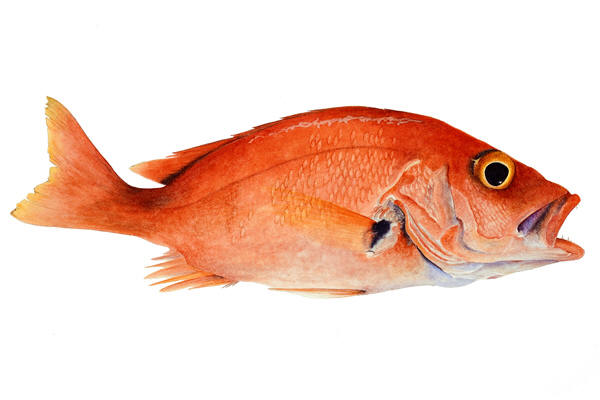 Blackfin
Snapper (Lutjanus buccanella)The blackfin snapper is
found in the tropical West Atlantic Ocean, from Massachusetts to Brazil,
although it is rare north of North Carolina. It is also found near
shorelines in the Gulf of Mexico and common throughout the Caribbean.
Living over sandy and rocky bottoms near ledges, the blackfin snapper
occurs in waters 200-300 feet deep. The adults live offshore near the
continental shelf. The young typically inhabit rocky outcroppings near
reefs in shallow waters of 20-60 feet. The blackfin snapper is often
observed schooling in groups of 20-30 individuals. This snapper is
similar to others in the Lutjanidae family because it has the same deep
body and double dorsal fin. Its caudal fin is rather truncate-shaped and
it has a long pectoral fin. The anal fin is rounded. This snapper has an
average length of 12 inches with a maximum length of 16 inches. Sexual
maturation occurs when females reach approximately 7 inches and males
reach approximately 15 inches. Average weight is 3-4 pounds. The
blackfin snapper is a carnivorous predator, feeding near the bottom of
the ocean. It is an opportunistic feeder, preying on any small fish
within range. Young blackfin snapper feed on shrimp, worms, and other
small invertebrates, switching to small finfish as they mature. The
blackfin snapper is a popular game and excellent food fish. It is
sometimes marketed as red snapper. Blackfin
Snapper (Lutjanus buccanella)The blackfin snapper is
found in the tropical West Atlantic Ocean, from Massachusetts to Brazil,
although it is rare north of North Carolina. It is also found near
shorelines in the Gulf of Mexico and common throughout the Caribbean.
Living over sandy and rocky bottoms near ledges, the blackfin snapper
occurs in waters 200-300 feet deep. The adults live offshore near the
continental shelf. The young typically inhabit rocky outcroppings near
reefs in shallow waters of 20-60 feet. The blackfin snapper is often
observed schooling in groups of 20-30 individuals. This snapper is
similar to others in the Lutjanidae family because it has the same deep
body and double dorsal fin. Its caudal fin is rather truncate-shaped and
it has a long pectoral fin. The anal fin is rounded. This snapper has an
average length of 12 inches with a maximum length of 16 inches. Sexual
maturation occurs when females reach approximately 7 inches and males
reach approximately 15 inches. Average weight is 3-4 pounds. The
blackfin snapper is a carnivorous predator, feeding near the bottom of
the ocean. It is an opportunistic feeder, preying on any small fish
within range. Young blackfin snapper feed on shrimp, worms, and other
small invertebrates, switching to small finfish as they mature. The
blackfin snapper is a popular game and excellent food fish. It is
sometimes marketed as red snapper. 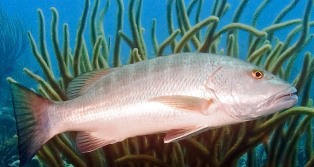 Cubera
Snapper
(Lutjanus cyanopterus) The cubera snapper ranges from
Massachusetts to Brazil in the western Atlantic Ocean. It is a tropical
species and is rare north of Florida and in the Gulf of Mexico. Cubera
snappers are solitary reef dwellers. Living inshore or nearshore, they
most often associate with ledges over rocky ledges and overhangs. They
live at depths to 175 feet below the water surface. The young typically
inhabit inshore mangrove areas and seagrass beds that offer some
protection from predators. Small cubera also are known to enter
estuaries, mangrove areas, and the tidal reaches of streams and
freshwater canals. These fish are generally gray or dark brown with pale
to dark gray sides. Common weighing around 40 pounds and reaching
lengths of 3 feet, the cubera snapper may reach up to 125 pounds and 5
feet in length. This snapper is easily the largest snapper occurring in
the Atlantic Ocean. An aggressive, carnivorous fish, the cubera snapper
feeds primarily on fishes and crabs. The strong canines allow mature
cubera to feed on large crustaceans including lobsters and crabs.
Feeding grounds are typically located near the bottom in rocky reef
areas or adjacent to other structures. The cubera snapper is a popular
game and food fish. Cubera
Snapper
(Lutjanus cyanopterus) The cubera snapper ranges from
Massachusetts to Brazil in the western Atlantic Ocean. It is a tropical
species and is rare north of Florida and in the Gulf of Mexico. Cubera
snappers are solitary reef dwellers. Living inshore or nearshore, they
most often associate with ledges over rocky ledges and overhangs. They
live at depths to 175 feet below the water surface. The young typically
inhabit inshore mangrove areas and seagrass beds that offer some
protection from predators. Small cubera also are known to enter
estuaries, mangrove areas, and the tidal reaches of streams and
freshwater canals. These fish are generally gray or dark brown with pale
to dark gray sides. Common weighing around 40 pounds and reaching
lengths of 3 feet, the cubera snapper may reach up to 125 pounds and 5
feet in length. This snapper is easily the largest snapper occurring in
the Atlantic Ocean. An aggressive, carnivorous fish, the cubera snapper
feeds primarily on fishes and crabs. The strong canines allow mature
cubera to feed on large crustaceans including lobsters and crabs.
Feeding grounds are typically located near the bottom in rocky reef
areas or adjacent to other structures. The cubera snapper is a popular
game and food fish.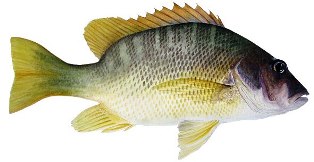 Dog
Snapper (Lutjanus jocu ) The adult dog snapper is
commonly found around coral reefs and rocky bottoms at depths of 16-100
feet, while the young can be seen in estuaries and have been known to go
inshore and swim into rivers. The dog snapper is one of the only
lutjanids to be found in freshwaters. Dog snappers are solitary and wary
fish, preferring secluded areas of the reef. Dog snappers have olive
green upper sides and backs, sometimes with narrow pale bars. The lower
sides and belly are light red and copper-colored. With an average length
of 24 inches, the adult dog snapper may reach a maximum length of 30
inches. The maximum weight known for this snapper is 20 lbs. Sexual
maturity is obtained at lengths of 12-16 inches. Dog
Snapper (Lutjanus jocu ) The adult dog snapper is
commonly found around coral reefs and rocky bottoms at depths of 16-100
feet, while the young can be seen in estuaries and have been known to go
inshore and swim into rivers. The dog snapper is one of the only
lutjanids to be found in freshwaters. Dog snappers are solitary and wary
fish, preferring secluded areas of the reef. Dog snappers have olive
green upper sides and backs, sometimes with narrow pale bars. The lower
sides and belly are light red and copper-colored. With an average length
of 24 inches, the adult dog snapper may reach a maximum length of 30
inches. The maximum weight known for this snapper is 20 lbs. Sexual
maturity is obtained at lengths of 12-16 inches. 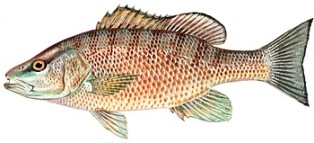 Gray
Snapper (Lutjanus griseus) The gray snapper is found
in the western Atlantic Ocean from Massachusetts to Bermuda, southward
to Brazil, including Bermuda, Bahamas, West Indies, Gulf of Mexico and
Caribbean Sea. It is especially abundant around the coastline of
Florida. Gray snappers reside in coastal as well as offshore waters from
very shallow areas to depths of 585 feet. Large aggregations of this
snapper are frequently observed amongst coral reefs, rocky areas,
estuaries, and mangrove habitats. Adults of the species tend to remain
in the same area for long periods once established and tagging studies
have shown little movement for periods of time as great as 4 years.
However, within such a range the species exhibits daily activity
patterns associated with nocturnal feeding and diurnal schooling. Young
gray snapper live inshore in areas such as seagrass beds as well as soft
and sand-bottom areas but may be found in a variety of habitats and a
number of inshore habitats are important nurseries for this species.
Both adults and juveniles have been found in freshwater lakes and rivers
in south Florida, a clear indication that the species is tolerant of a
broad range of salinity levels. The gray snapper is one of the smaller
snappers, rarely exceeding 18 inches in length, and is almost always
less than10 pounds. Gray snapper are opportunistic predators. Larvae
feed on zooplankton including copepods and amphipods. Gray
Snapper (Lutjanus griseus) The gray snapper is found
in the western Atlantic Ocean from Massachusetts to Bermuda, southward
to Brazil, including Bermuda, Bahamas, West Indies, Gulf of Mexico and
Caribbean Sea. It is especially abundant around the coastline of
Florida. Gray snappers reside in coastal as well as offshore waters from
very shallow areas to depths of 585 feet. Large aggregations of this
snapper are frequently observed amongst coral reefs, rocky areas,
estuaries, and mangrove habitats. Adults of the species tend to remain
in the same area for long periods once established and tagging studies
have shown little movement for periods of time as great as 4 years.
However, within such a range the species exhibits daily activity
patterns associated with nocturnal feeding and diurnal schooling. Young
gray snapper live inshore in areas such as seagrass beds as well as soft
and sand-bottom areas but may be found in a variety of habitats and a
number of inshore habitats are important nurseries for this species.
Both adults and juveniles have been found in freshwater lakes and rivers
in south Florida, a clear indication that the species is tolerant of a
broad range of salinity levels. The gray snapper is one of the smaller
snappers, rarely exceeding 18 inches in length, and is almost always
less than10 pounds. Gray snapper are opportunistic predators. Larvae
feed on zooplankton including copepods and amphipods.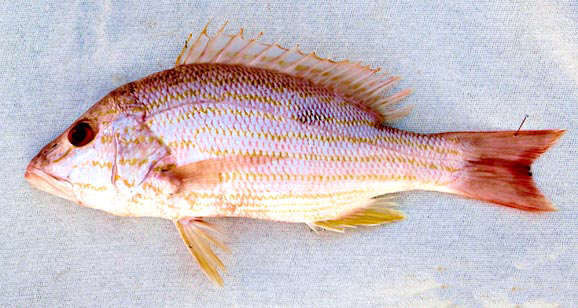 Lane
Snapper (Lutjanus synagris) The lane snapper is found
in the western Atlantic Ocean, from North Carolina to southern Brazil.
It is most abundant in the Antilles, off Panama, and the northern coast
of South America. It also occurs in Bermuda and the Gulf of Mexico. The
lane snapper has a fairly deep body with a pointed snout. It has a
double dorsal fin, with a rounded anal fin and relatively short pectoral
fins. The caudal fin is emarginate to slightly forked. Lane snappers
have an average length of 14 inches, with a maximum length of 20 inches.
They usually weigh less than a pound. Sexual maturity is reached at
lengths of 3-9 inches. The estimated maximum age of the lane snapper is
10 years. Adult lane snappers live in a variety of habitats, but are
most commonly observed over reefs and vegetated sandy bottoms in shallow
inshore waters. This species has also been reported in offshore waters
to depths of 1300 feet. Once established, adult snappers remain in the
same area for their entire lives. Lane snappers also occur in seagrass
beds associated with shrimping areas. Juveniles live in protected
inshore areas. Lane snapper have two color phases. The deep-water phase
coloration is darker and more pronounced than those with the
shallow-water resting phase coloration. Both color phases have pink to
red upper sides and backs with a green tinge. The lower sides and belly
are silver with a yellow tinge. Lane
Snapper (Lutjanus synagris) The lane snapper is found
in the western Atlantic Ocean, from North Carolina to southern Brazil.
It is most abundant in the Antilles, off Panama, and the northern coast
of South America. It also occurs in Bermuda and the Gulf of Mexico. The
lane snapper has a fairly deep body with a pointed snout. It has a
double dorsal fin, with a rounded anal fin and relatively short pectoral
fins. The caudal fin is emarginate to slightly forked. Lane snappers
have an average length of 14 inches, with a maximum length of 20 inches.
They usually weigh less than a pound. Sexual maturity is reached at
lengths of 3-9 inches. The estimated maximum age of the lane snapper is
10 years. Adult lane snappers live in a variety of habitats, but are
most commonly observed over reefs and vegetated sandy bottoms in shallow
inshore waters. This species has also been reported in offshore waters
to depths of 1300 feet. Once established, adult snappers remain in the
same area for their entire lives. Lane snappers also occur in seagrass
beds associated with shrimping areas. Juveniles live in protected
inshore areas. Lane snapper have two color phases. The deep-water phase
coloration is darker and more pronounced than those with the
shallow-water resting phase coloration. Both color phases have pink to
red upper sides and backs with a green tinge. The lower sides and belly
are silver with a yellow tinge. |
|
|
Advertise | Privacy Statement | Dog Encyclopedia | Video |Contact | Alaska Nature |
|